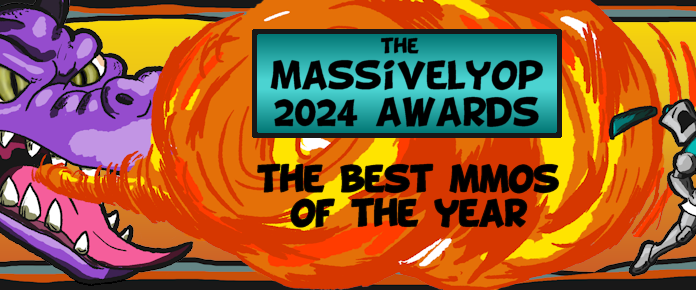
It’s been just over a month now since Monster Hunter World launched on PlayStation 4 and Xbox One, heralding a brand-new generation of Capcom’s acclaimed action-RPG franchise. As the first entry in the series developed for current-gen, non-handheld consoles since 2009’s Monster Hunter Tri, World marks a major transition for the series, one that brings with it sweeping changes to the time-honored formula upon which the series was built. There’s been, of course, some anxiety among the game’s community about what these changes might mean for the game’s future, with some fearing that the game would be watered down to attract a wider audience.
However, after putting a frankly embarrassing number of hours into the game, I’m happy to be able to say that there’s no need to panic. New features have been added, mechanics have been streamlined, and the world – fittingly enough – is more expansive and engrossing than ever. That’s not to say that the jump to a new generation has come without its costs, but make no mistake: For all its sweeping changes, World is still Monster Hunter through and through. And if you ask me, it’s the best one yet.
The most obvious benefit of the leap from handhelds to modern home consoles is, of course, the enhanced graphical capabilities, and World takes full advantage of it. I don’t know what to say except that it’s gorgeous. The environments, the characters, the monsters, all of them are rendered with loving detail, and there’s been many a time that I’ve stopped mid-hunt just to soak in the beauty of the world around me. Performance-wise, the game runs well enough on a standard-model Xbox One, maintaining a fairly steady 30 FPS, give or take depending on the situation. Admittedly, it’s not ideal, and I still can’t wait for the PC version for that sweet, sweet 60 FPS goodness, but the performance never seriously detracted from my enjoyment of the game.
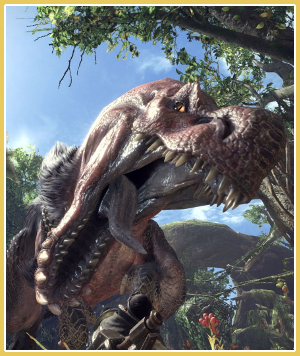
World also puts a greater emphasis on narrative than its predecessors. While resource limitations in prior entries have generally relegated narrative delivery to quest descriptions and NPC dialogue, World puts the story at the forefront with frequent cinematics and cutscenes throughout the game. Cutscenes are fully voice-acted, and the dialogue is available in English, Japanese, and – to my immense delight – Monster Hunter’s signature gibberish language. Admittedly, the game’s plot isn’t the most enthralling story ever told, but I nevertheless found myself far more invested in it than I ever was in the narratives of previous games. And really, the cutscenes are, by-and-large, quite well done, but I’d really appreciate being able to skip them, especially on subsequent playthroughs.
Some of the biggest changes in World have been made to the early-game experience, which has been retooled to be a bit more accessible to newcomers and even out the game’s notoriously steep learning curve. World begins with a short introductory segment to familiarize players with the basics, and there are proper tutorial pop-up windows as they encounter new mechanics, providing succinct and straightforward explanations of the game’s myriad systems and features that can be reviewed at any time. It’s a huge step up from the series’ traditional tactic of burying mechanical explanations and gameplay hints in NPC dialogue, and I think it’ll do wonders for attracting new players to the game and keeping them there.
Another great new feature that’s sure to please newcomers and veterans alike is the training room, where players can experiment with each of the game’s 14 weapon types. It’s perfect for learning new weapons, perfecting combos, and checking out your damage numbers before you head out into the field. It’s no substitute for honing your skills in the heat of battle, of course, but at least it lets players get a feel for their weapon’s combos and playstyle without having to worry about a monster trying to tear their faces off while they learn the ropes.
While the introductory experience and tutorial windows are obviously most beneficial to new players, even experienced hunters will find them useful for learning about the many new features and mechanical changes introduced in World. One of the first things that veteran hunters will likely notice is that paintballs are a thing of the past. Instead, World introduces Scoutflies, helpful little firefly-like insects that assist hunters by highlighting nearby gathering points and, more importantly, monster traces. Monster traces, such as footprints, clawmarks, and – ugh – mucus trails, are scattered throughout each zone, and by interacting with these traces, hunters can locate, track, and gather research information about the monsters that left them.

As you find and interact with monster traces, it fills up a “tracking gauge.” When it’s full enough, your Scoutflies will be able to start guiding you to the nearest trace left by that monster and, eventually, to the monster itself. Moreover, each monster trace that you inspect will provide you with research points. In addition to acting as a sort of currency that you can use to pay for certain things within the game, such as canteen meals, resource points also contribute to the guild’s ecological research efforts.
Each large monster has an individual ecological research level that is increased as you investigate its traces in the field. Leveling up your research levels serves multiple purposes: First, the higher your ecological research level for a given monster, the more easily your Scoutflies can track that monster in the field, meaning that your tracking gauge will fill up faster when examining monster traces. Second, as your ecological research level for a monster increases, the information about that monster displayed in your hunting notes becomes more detailed, revealing the monster’s strengths, weaknesses, and other valuable intel.
In addition to the mechanical benefits that the research system adds, I think it’s a great dash of flavor as well. While there’s certainly a part of me that mourns the loss of our trusty paintballs, this new system really serves to make you feel like an actual hunter, tracking your quarry by following the trails it leaves behind. And since the whole premise of the game’s story is that players are part of a research commission sent to investigate the “new world,” the ecological research mechanics help to heighten the illusion that you’re not just killing monsters for the sake of making snazzy clothes out of their parts (but let’s be real, you totally are).
Hunters in World also get a brand-new toy, the slinger. This wrist-mounted crossbow’s primary use is to fire various types of projectiles, called slinger pods. Some pods, such as flash, dung, and screamer pods (which replace the hand-thrown bombs of previous entries), can be crafted and carried in your pack during quests, while a variety of other types of pods can be found and gathered from the environment. Slinger pods can be fired directly at monsters to inflict damage and ailments, or they can be used to trigger certain environmental hazards, which we’ll get to in a bit. The slinger also has a secondary function as a grappling hook, granting hunters increased mobility options for traversing the game world.
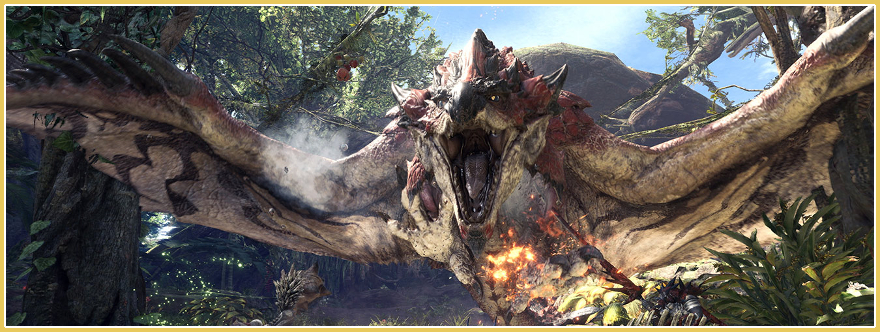
Scoutflies and slingers aren’t the only new additions to hunters’ arsenals, however; World also introduces new types of hunting equipment: mantles and boosters, both of which players unlock as they progress through the game. Mantles are special cloaks, each of which imbues its wearer with a special attribute or buff, such as a damage shield, knockback immunity, and so on. The boons that mantles confer can be remarkably powerful, but they can only be worn for a limited time before the effect wears off, after which the mantle has to be taken off until its cooldown is up.
Boosters aren’t technically new per se, as similar items have existed as consumables in previous games, but they’re still worth mentioning. Essentially, boosters are smoke bombs that hunters can place on the ground, granting beneficial effects like healing-over-time or increased crit chance to the hunter and his allies while they remain within range. They’re immensely useful tools, especially in multiplayer hunts. Like mantles, boosters remain active only for a limited time, after which there’s a cooldown before they can be used again.
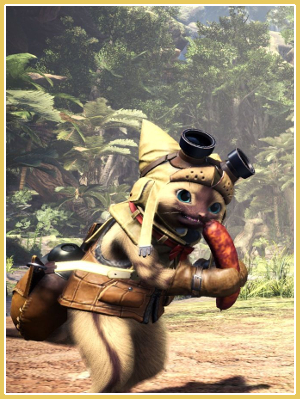 And of course, we can’t neglect hunters’ steadfast companions, the adorable and unwaveringly loyal Palicoes. As in previous entries, each hunter has a Palico companion that they customize and name at character creation, and who can be outfitted with new weapons and armor throughout the game. However, World streamlines the Palico leveling and skill systems of previous games with the introduction of Palico gadgets.
And of course, we can’t neglect hunters’ steadfast companions, the adorable and unwaveringly loyal Palicoes. As in previous entries, each hunter has a Palico companion that they customize and name at character creation, and who can be outfitted with new weapons and armor throughout the game. However, World streamlines the Palico leveling and skill systems of previous games with the introduction of Palico gadgets.
There are six different Palico gadgets that hunters can unlock as they progress through the game. A Palico’s equipped gadget will determine the abilities a Palico will use in combat – the Vigorwasp Spray gadget, for instance, allows equipped Palicoes to heal the hunter and his allies, while the Coral Orchestra gadget lets Palicoes play stat-boosting songs similar to those provided by the Hunting Horn.
As Palicoes participate in hunts with a particular gadget, their proficiency with that gadget will rise, eventually unlocking new and more powerful abilities. Notably, World is the first game in the series (to my knowledge, but please correct me if I’m wrong) that allows hunters to activate Palico abilities on command, the same way they would use a consumable item, which in my opinion makes Palicoes more useful than ever, even if the gadget system does somewhat limit Palico customization in comparison to the more granular and detailed systems used in previous entries.
Despite all the new additions and changes to the game’s standard formula, the core MH gameplay loop remains firmly intact: You begin in the hub town – in World’s case, the village of Astera – where you can shop, craft, and set out on hunts, which send you out into one of the game’s five explorable zones where you’ll gather resources, hunt monsters, and carve them up for parts so you can go back to Astera and repeat the process. Nevertheless, World makes quite a few alterations and additions to the overall questing-and-hunting experience.

As before, quests are divided into key quests (or as they’re called in World, assigned quests) – which must be completed to advance through the main plotline and unlock new zones, hunts, and so on – and optional quests, which are repeatable and sometimes offer unique rewards and unlocks. For the most part, the quests themselves are identical to those of previous MH games, requiring hunters to gather the specific items or hunt the designated monster(s). But occasionally – most often for certain assigned quests – quests will require hunters to conduct research by examining monster traces of a certain type or in a specific zone to fill the quest’s progress bar until it’s complete.
Maybe it was just me being unlucky, unobservant, or some combination of the two, but these segments tended to drag on for me, and I eventually came to dread them. Trawling through the game’s expansive and occasionally labyrinthine zones looking for just one more Nergigante thorn or whatever starts out fine but gets increasingly tedious over time. Thankfully, most if not all of these research quests can be alternatively progressed by completing optional quests in the appropriate zone, which I found to be preferable more often than not, but your mileage may vary.
World’s approach to quests is also notable because it does away with the separation of offline and online quests. Every quest in the game from start to finish can be completed in online multiplayer, meaning that hunters can play through the entire game together. Or that was the idea, anyway. Unfortunately, one minor but glaring problem throws a wrench in that plan.
See, if a quest includes a cutscene, as is the case for almost every single one of the assigned quests, then you can’t undertake that quest with other players unless everyone in the group has already viewed the cutscene in question. This means that if multiple players are trying to play through the story together, then every time the situation arises, they each individually have to start the quest, progress through it until they reach the cutscene (frequently upon encountering a large monster for the first time), view the cutscene, then abandon the quest and reembark on it together.

Sure, there’s a workaround, and it’s not the worst thing in the world, but it just seems a shame for what would otherwise be a fantastic experience in a series already renowned for its multiplayer mode to be marred by a single frustrating and seemingly avoidable obstacle. It’s made all the more frustrating in light of the other multiplayer-focused additions and improvements. The addition of squads – persistent groups roughly analogous to guilds – and the expanded 16-player limit for online lobbies are both encourage online play, as does the S.O.S. system, which allows players to join the hunts of players who have called for help.
In addition to the core assigned and optional quests, World introduces two new hunting options. The first, expeditions, are effectively “free hunts” that allow players to explore and hunt in any unlocked zone with neither set objectives nor time constraints. Although this isn’t the first time the series has included a free-hunt mode of some kind, it’s arguably the most expansive iteration of the idea, and it serves an important purpose in the broader context of the game.
Firstly, expeditions are great for gathering resources, which has been streamlined significantly: Harvesting resource nodes is now substantially faster than the leisurely foraging of previous entries and no longer requires tools like pickaxes, bug nets, and fishing rods, both of which are welcome changes to me. And secondly, at high-rank, monsters must first be hunted or captured in order to unlock their corresponding optional quests, and for some monsters, the only way to do so is to find them on expeditions.
Unfortunately, there’s no straightforward way to embark on an expedition with other players. I’m still holding out some hope that the devs can find a way (and go through the trouble) to change that, but in the meantime, there’s another workaround that involves starting then completing or abandoning a quest with your group, then choosing to return to the zone’s base camp rather than to Astera when prompted. Again, it’s not the worst thing in the world, but it’s not ideal, either.
The other new quest option comes in the form of investigations, which are semi-randomly generated quests that can be acquired by completing various tasks, such as killing or capturing monsters, investigating monster traces, etc. Once acquired, investigations are stored in a list separate from the assigned and optional quests, from which players can choose which investigations they wish to undertake, at which point they are added to the optional quests menu.
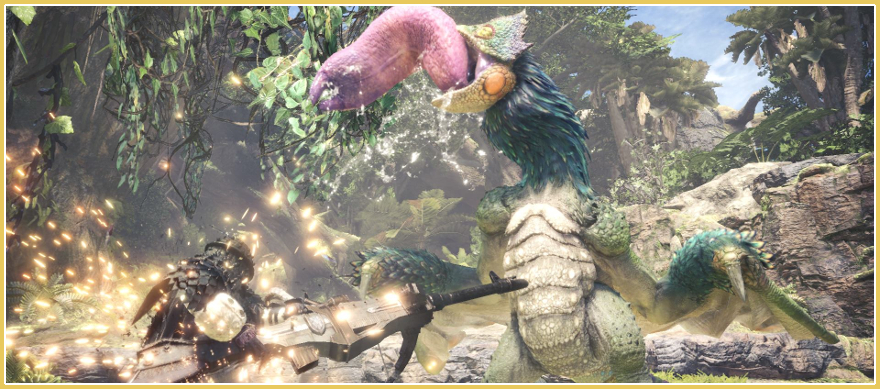
Investigations are unique from other quests in a couple of key ways: First, they can be subject to various modifiers that can change the difficulty of the quest in question. Modifiers include longer or shorter time limits, increased or decreased faint limits, boosted zenny rewards, and so on. Second, investigation quests provide additional item rewards upon completion. The number of additional items rewarded by an investigation, as well as the quality thereof, is listed on the investigation menu in the form of a number of icons, color-coded bronze, silver, or gold, with bronze denoting lower-rarity items and gold denoting high-rarity ones.
These additional rewards make investigations an often-preferable avenue for hunters who need to farm parts from a particular monster, but there are downsides: As mentioned, the quest modifiers can make particular hunts more difficult than their standard counterparts. Moreover, once an investigation has been accepted, the quest it provides can be completed a limited number of times, after which the investigation disappears.
I love investigations as a way of expediting the process of farming parts, and I don’t have any real issues with the investigation mechanics themselves. The way that they’re presented, however, could use a little work. As it stands, new investigations are simply added to a perpetually growing list, and unless you constantly curate and prune it, you’ll eventually end up with a massive collection of investigations of varying levels of usefulness. A way to filter investigations by target, rank, etc. would be a huge quality-of-life improvement, as would a way to mass-delete investigations that you don’t want to hang on to.
No matter what type of quest you set out on, once you get out into the field and on the hunt, it’s more or less business as usual, although with some notable changes. World’s most striking shift from previous generations is, appropriately enough, in the world itself. The hunting zones are beautiful, sprawling, and for the first time in the series, seamless. Although zones are still nominally divided into distinct, numbered areas, there are no longer any loading screens between them.

To make it a bit more convenient to navigate the massive new zones, World introduces campsites, which serve as spawn points and fast-travel points in addition to providing hunters access to useful facilities. Most zones initially contain only a single campsite, but as players explore, they’ll discover areas where new campsites can be built by delivering the required resources. Each camp contains a tent where players can access their equipment and item boxes, the trusty supply box where hunters can find guild-supplied items at the start of a quest, and a full-service canteen to serve up stat-boosting meals.
The size and seamlessness of the new zones is a huge step up for the series, giving the world a sense of scope and a level of detail like never before, but it does come at a cost: World has only five unique explorable zones (not counting a few smaller zones that are used only for specific quests) compared to MH4U’s seven and MHGen’s whopping eleven, so there’s not quite as much biome diversity. Moreover, there don’t seem to be as many small monsters, which can lead to some areas feeling rather empty and lifeless despite their beauty. But on the other hand, it also means no Konchu, so… We’ll call it even? Overall, I think the benefits of the new environments vastly outweigh the costs.
The new-and-improved environments aren’t just cosmetic; hunters can now interact with their surroundings in various ways, making the environment in which you fight more meaningful than it has been since the mounting mechanic was first introduced in MH4U. Now, hunters can launch aerial attacks not only by leaping from elevated terrain, but by running up certain types of walls, swinging from dangling vines, or using the grappling-hook function of their slinger to attach to the oddly-named (and astonishingly sturdy) wedge beetles scattered throughout each zone. World also introduces sliding attacks, which can be used by sprinting down a sufficiently steep incline, letting you slide down the hill and enabling you to launch a unique jumping attack once you’ve gathered enough momentum.
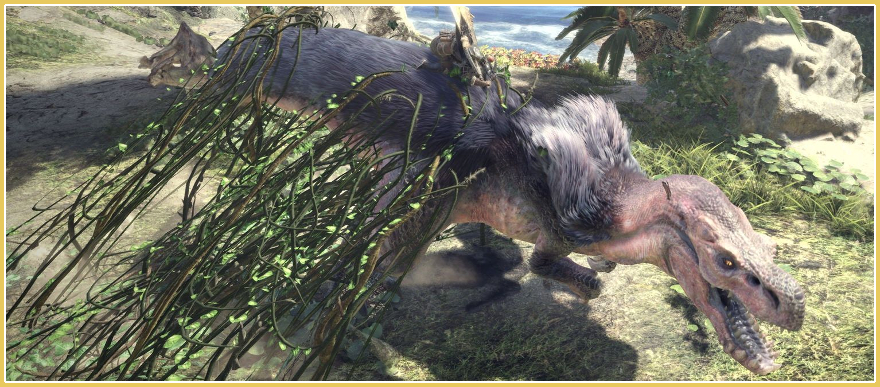
World also introduces environmental hazards that hunters can exploit to get the upper hand against their foes – or vice versa, if they’re not careful. Hunters can hit stalactites on cave ceilings with slinger shots to dislodge them and rain rocks on anything unfortunate enough to be standing beneath them, or they can lead their unassuming quarry into tangles of ivy to immobilize them for a short time. They can even exploit the endemic wildlife to their advantage: Flashbugs scattered around each zone can be hit to produce a flashbomb-like effect, and there’s a particularly evolutionarily-questionable variety of toad that violently explodes when disturbed by, say for instance, a swift kick from an unscrupulous hunter.
Aside from those additions, however, combat itself in World remains largely unchanged from its origins. The array of combat options available to hunters may have changed, but the core of its methodical, challenging, and dare I say Dark-Souls-esque combat has been faithfully translated. The controls are still tight and responsive, and attack hitboxes remain fair and clean – except for Nergigante’s dive attack, which I maintain is outrageous, and I’m definitely not just saying that because I’m permanently salty from all the times I’ve died to it.
There is, however, one brand-new hunting mechanic: the much-vaunted turf wars, in which large monsters battle for supremacy when they encounter one another. Don’t get me wrong, I think it’s a great feature that adds a lifelike dynamic to the game’s ecosystems, but I also think it might have been oversold a bit. Turf wars happen so frequently and predictably that they quickly cease to be a spectacle and become a nuisance, as it’s virtually a certainty on any given hunt that another monster will eventually show up and pick a fight with your target. In my experience, it’ll be Bazelgeuse, who apparently knows no greater joy in life than carpet-bombing you in the middle of a fight. Dick.
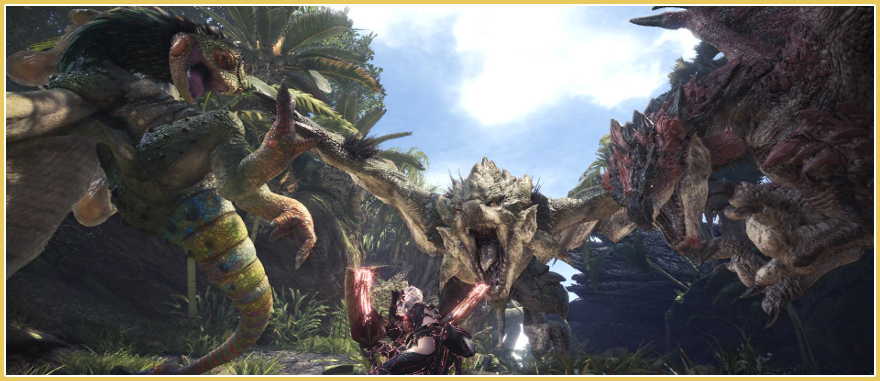
Of course, it wouldn’t be a Monster Hunter game without the monsters themselves. World’s roster is a pretty solid mix of fresh and familiar faces; of the game’s 30 large monsters, 18 of them are new creations for World. The overall variety of monster types, however, is unfortunately somewhat lacking, but since all the monster models and animations, like everything else in the game, had to be made from scratch rather than ported from a previous version, it’s understandable, and hopefully we’ll see a bit more diversity in future DLC.
The one big disappointment on World’s roster, in my opinion, is the elder dragon Zorah Magdaros, which serves as the “big bad” (so to speak) of the first half of the game or so. Without going into too much detail, the battles with him are thoroughly tedious and severely underwhelming, with the final encounter consisting largely of running around loading and firing cannons with virtually zero sense of danger, urgency, or challenge.
 We’ve covered the where, how, and what of hunting, and that brings us to the why: sweet, sweet gear. Equipment, and the crafting thereof, has undergone some significant changes in World, most notably in the way that armor skills are implemented. Whereas the previous games measured armor skills in “points,” where a certain number of points in a given skill were necessary to activate its effects, World uses levels, which does away with the issue of having useless skill points on your gear and cuts down on the arithmetic required to plan out your build. In addition, negative skills are no more. Whether you see this change as a welcome streamlining of an unnecessarily obtuse system or a watering down of the game’s complexity is a matter of perspective, but I happen to fall into the former camp. The depth of customizing your armor set to get the skills you want is still there, just without having to worry about reaching skill-activation thresholds and counteracting penalties.
We’ve covered the where, how, and what of hunting, and that brings us to the why: sweet, sweet gear. Equipment, and the crafting thereof, has undergone some significant changes in World, most notably in the way that armor skills are implemented. Whereas the previous games measured armor skills in “points,” where a certain number of points in a given skill were necessary to activate its effects, World uses levels, which does away with the issue of having useless skill points on your gear and cuts down on the arithmetic required to plan out your build. In addition, negative skills are no more. Whether you see this change as a welcome streamlining of an unnecessarily obtuse system or a watering down of the game’s complexity is a matter of perspective, but I happen to fall into the former camp. The depth of customizing your armor set to get the skills you want is still there, just without having to worry about reaching skill-activation thresholds and counteracting penalties.
Weapon crafting and upgrading remains largely unchanged, except for a couple of details: Firstly, the UI has been changed to allow you to see a visual depiction of the weapon upgrade tree, which in my opinion makes it a good deal easier to plan out your progression path. Secondly, you can now revert upgraded weapons to their previous forms (as long as they haven’t been upgraded past certain points), recovering the upgrade materials used and allowing you to experiment with different upgrade paths a bit before you fully commit to one.
As with other areas of the game, as I’ve mentioned, World’s equipment suffers from a lack of variety, particularly in the visuals department. There aren’t nearly as many unique weapon models as there have been in previous games, and the number of unique final-form weapon models is particularly slim. That being said, I do rather like the way that, as you upgrade a weapon between one form and the next, the upgrades are visually represented on the weapon’s model, with monster bits being gradually grafted onto the initial model as it’s upgraded.
World shifts drastically from its predecessors in how it handles charms and decorations. Whereas charms have historically been dropped with randomly generated skills, now they’re crafted and upgraded like any other piece of equipment. While this does put a bit more of a limitation on the variety of ridiculous builds that can be achieved with particularly good charm skill rolls, I personally can’t say that I’m going to miss endlessly farming for that perfect drop. But if you will, don’t worry, there’s still plenty of RNG-heavy grinding to be done thanks to the new implementation of armor decorations.
While some decorations can still be crafted as in previous games (though in World it’s done through the Elder Melder), the best and most powerful decorations can be acquired only through random drops from high-rank and endgame quests or by melding three other decorations into a random new decoration, the latter of which requires rare endgame materials to perform.
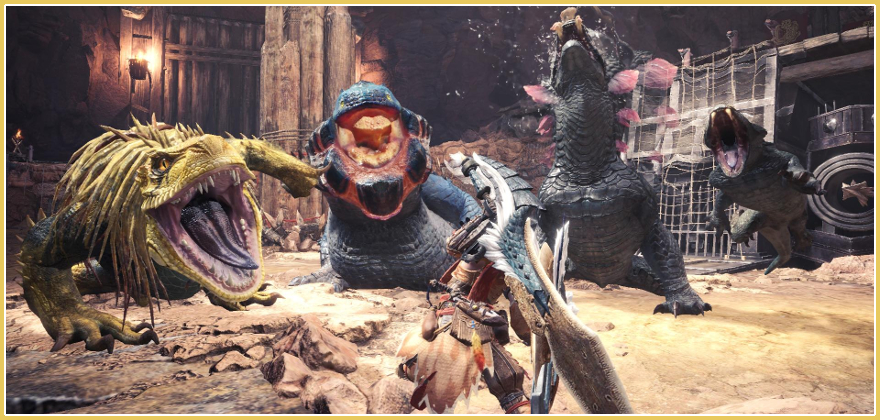
As for the endgame itself, it’s more of the same, really. After completing the main storyline, you’ll be able to unlock tempered monsters, which are more powerful versions of the creatures you’ve already encountered. In order to unlock the quests to hunt these beefed-up baddies, you have to search out special tempered-monster traces in the wild, which your scoutflies will highlight in blue rather than the standard green.
Unfortunately, other than being statistically stronger, tempered monsters are identical to their standard counterparts, so while they hit harder and last longer, the fights themselves are effectively the same. If I’m being honest, I haven’t felt particularly compelled to bother with them too much, but if you’re looking for endgame activities, that’s where you’ll be spending your time. Tempered monsters have a chance to drop powerful decorations and rare materials called streamstones, which, in addition to being necessary for decoration melding as I mentioned above, can be used to augment fully-upgraded weapons and armor, which can boost an item’s stats beyond its normal limits, grant special effects (such as causing successful attacks to heal you), or add additional decoration slots.
Once you’ve reached the point in the game where you have access to tempered monsters and augmentation, the only real benefit to farming decorations and streamstones is to make it easier to fight even more tempered monsters, so if I’m being honest, I feel like there’s not too much incentive to keep playing once you hit endgame. That doesn’t make World particularly unique among games in the series, whose endgames have often been more about the challenge of the hunt than the mechanical rewards, but I still wouldn’t complain about seeing more endgame features added in future updates.
But considering the sheer amount of content packed into World, I think that’s a minor and ultimately hollow criticism. I’ve put well over 100 hours into the game, and I’ve still yet to see everything that it has to offer. As far as I’m concerned, that’s well worth the price of admission. It may not be 100% perfect, but Monster Hunter: World has laid the foundation for what I hope is only the beginning of an exciting new era for the series, and I can’t wait to see where it goes next.

